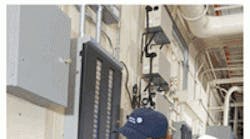In 2008, the University of Minnesota made a public commitment to reduce its overall energy consumption by 5 percent by June 2010. With 323 buildings on two campuses located 150 miles apart, it reached out to Johnson Controls to integrate systems with no disruption in day-to-day operations.
Johnson Controls installed a multivendor head-end workstation to standardize protocol between disparate systems. This involved the integration of a number of legacy building-automation systems controlling 28,000 physical points. Other legacy control systems were replaced with a Metasys 5.0 building-management system, now a common user interface controlling and monitoring nearly 60,000 physical points.
The university served as alpha and beta user during the development of the Metasys 5.0 upgrade. Now recognized as the largest application of the system in North America, the university has implemented stringent BACnet-compatibility standards. Nearly 80 percent of campus systems operate on the protocol.
"We launched a full-scale BACnet product with a user interface that was Web-enabled, which is something we were looking for," Mark Peterson, the university's senior controls engineer, said. "As we upgrade to BACnet-compatible equipment, it can be easily integrated into the head end."
As equipment is updated over time, BACnet-compatible equipment takes its place, and legacy control systems are replaced, enabling the university to centrally monitor and control all building systems.
"We needed a service provider who was very receptive to assisting us with technology challenges, such as alarm management and communications, across our disparate controls systems," Peterson said. "Other suppliers said they could do it, but Johnson Controls worked with us through alpha and beta tests to accomplish it with their products. As a result, instead of needing multiple monitors to view and respond to alarms from different vendors' systems, the alarms all look the same and can be viewed from a single workstation."
From an operations standpoint, the university now is divided into four districts, with systems and equipment monitored around the clock seven days a week.
To manage the data collected and meet its 2010 goal, the university required accessible reporting capabilities. Under this model, nearly 120 authorized individuals access real-time data and view top-line information, including current building-temperature and humidity levels. The Metasys system requires minimal training to make adjustments and respond to alarms on its user-friendly interface.
Another use of the system is calculating the number of hours in a week fans have run and comparing that to their schedule and maintenance deadlines.
"This helps us see if fans are not running as programmed or if schedules are being overridden, which would be difficult to do otherwise with such a large university," Peterson said. "We created that report with all of the BACnet vendors and use the system to harvest the data, which is then stored and published on the Web for people to see as dashboard metrics. At any given time, authorized personnel can look at energy usage in a building."
The system has decreased the frequency of maintenance calls, enabling mechanics and engineers to focus on more pressing matters.
While many of the users are members of the facilities staff who access the system at a supervisory level, others use the system as a tool in their daily jobs. Professors are able to fine-tune the schedule of HVAC and lighting in their classrooms, and researchers are able to control fume hoods and critical environments.
The university met its goal of reducing energy consumption by 5 percent by June 2010 three months earlier than planned, resulting in annual energy-cost savings of more than $2.4 million.
Information and photograph courtesy of Johnson Controls.
For Design Solutions author guidelines, call Scott Arnold, executive editor, at 216-931-9980, or write to him at [email protected].










